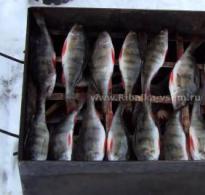What mushrooms are poisonous to humans? What poisonous mushrooms are hiding in Russian forests
Causes of mushroom poisoning
- Toxicity of the mushrooms themselves, due to the presence of toxins (or mycotoxins)
- Long-term storage of collected mushrooms without cooking them, or long-term storage already cooked mushrooms
- Damage to mushrooms by pests, in particular mushroom flies
- Concomitant consumption of certain types of mushrooms (e.g. dung beetles - Coprinus) with alcohol
- Accumulation during fungal growth in fruiting bodies harmful to the body substances (heavy metals, etc.)
- Frequent consumption of mushrooms of the Morel family ( Morchellaceae)
Abuse of mushrooms, even of the first category, is harmful to the body, since mushrooms are difficult to digest food and with a large volume of semi-digested mass in the gastrointestinal tract, intoxication of the body can develop.
Precautions when collecting and using mushrooms
The most common cases of poisoning are mushrooms that have an external resemblance to edible ones and are accidentally collected together with them. To avoid such a mistake, which can be fatal, it is necessary to thoroughly study the general characteristics of mushrooms and know the characteristic differences of poisonous species.
You should only collect the types of mushrooms that you know. Unknown or questionable fruiting bodies should not be eaten. It should be remembered that characteristic features may be absent in some specimens, for example, white flakes on the cap of a fly agaric can be washed away by heavy rain, the cap of a pale toadstool, cut off at the very top, does not allow you to notice the ring.
Many mushrooms are much more dangerous for children than for adults, so the consumption of even “good” mushrooms by children should be limited.
Mushrooms can pose a danger as accumulators of toxic substances (heavy metals, pesticides, radionuclides).
First aid measures
In case of severe mushroom poisoning, you should call a doctor.
Before the doctor arrives, the patient is put to bed, the stomach is washed: given plenty of fluids (4-5 glasses boiled water room temperature, drink in small sips) or a light pink solution of potassium permanganate and induce vomiting by pressing a finger or a smooth object on the root of the tongue. To remove poison from the intestines, immediately after gastric lavage, a laxative is given and an enema is performed.
To clarify the diagnosis, save all uneaten mushrooms.
Treatment for mushroom poisoning depends on the type. Poisoning with toadstool is accompanied by vomiting and dehydration; after gastric lavage, an exchange blood transfusion, hemodialysis, intravenous glucose and insulin are administered, and in case of respiratory failure, subcutaneous atropine.
Deadly poisonous mushrooms
Among mushrooms there are deadly poisonous species, that is, capable of causing fatal poisoning even with a small amount of mushrooms eaten. Deadly poisonous species are:
- Panther fly agaric ( Amanita pantherina)
- Death cap ( Amanita phalloides)
- Spring grebe ( Amanita verna)
- Amanita stinking ( Amanita virosa)
- Amanita ocreata
- Galerina bordered ( Galerina marginata)
- The whitish talker ( Clitocybe dealbata) (Сlitocybe candicans)
- Mountain gossamer ( Cortinarius orellanus)
- The most beautiful cobweb ( Cortinarius speciosissimus) (Cortinarius rubellus)
- Genus Lopastnik, or Helvella ( Helvella St. Am.) (* what kind of lobe, are there many edible species among lobes?)
- Entoloma poisonous ( Entoloma lividum)
- Entoloma crushed ( Entholoma rhodopolium)
- Patouillard fiberglass ( Inocybe patouillardii)
- Umbrella rough ( Lepiota aspera)
- Umbrella brown-red ( Lepiota brunnroincarnata)
- Chestnut umbrella ( Lepiota castanea)
- Umbrella thyroid ( Lepiota clypeolaria)
- Comb umbrella ( Lepiota cristata)
- Umbrella fleshy-reddish ( Lepiota helveola)
- Silverfish spores ( Lepiota ventriosospora)
The toxicity of certain types of fungi is currently not well understood, and data from sources is often contradictory. First of all, this applies to lines and false honey mushrooms, the toxicity of which depends on the area of growth. However, the toxins they contain: in the lines - gyromitrin, and in false honey mushrooms - phalla and amatoxins (pale toadstool toxins) - are deadly. Therefore, you should avoid eating them, even if in some sources these mushrooms (strokes and false brick-red honey fungus) are classified as edible or conditionally edible.
Mistaken “signs” of poisonous mushrooms
Folk signs that “allow us to determine poisonous mushrooms", are based on various misconceptions and do not allow us to judge the danger of mushrooms:
- Poisonous mushrooms have an unpleasant odor, while edible ones have a pleasant odor (the smell of toadstool is almost identical to the smell of champignons, although according to some, toadstool has no smell at all)
- "Worms" (insect larvae) are not found in poisonous mushrooms (misconception)
- All mushrooms are edible when young (the toadstool is deadly poisonous at any age)
- Silver objects in a decoction of a poisonous mushroom turn black (misconception)
- A head of onion or garlic turns brown when cooked with poisonous mushrooms (misconception)
- Poisonous mushrooms cause milk to sour (misconception)
Poisoning with some mushrooms
Phalloidin poisoning
Occurs when consuming certain amanita mushrooms, such as toadstool, stinking fly agaric, or spring toadstool. The following highly toxic substances were found in the pulp of these mushrooms:
- fallin
- several forms of amanitin
Fallin is neutralized by boiling, but other poisons are resistant to heat treatment and are not removed.
Phalloidin begins to cause profound changes in liver cells soon after ingestion, however, the first symptoms occur within 6 to 24 hours, sometimes after two days. Poisoning begins with severe abdominal pain, uncontrollable vomiting, severe sweating and diarrhea, and body temperature drops. In severe cases (and almost all such poisonings are severe!), kidney and heart failure begins, coma and death occur. Poisoning can last up to twenty days.
There are no reliable methods of treatment; even with timely medical care, up to 70% of such poisonings are fatal. Successful treatment can only be achieved if the diagnosis is quickly established (before the onset of symptoms); antiphalloid serums and thioctinic acid are used for treatment.
Orellanine poisoning or paraphalloid syndrome
Very severe poisoning, often fatal. Its symptoms are similar to those of phalloidin poisoning. Caused by the heat-resistant toxin orellanine, which is found in mushrooms such as the mountain spiderwort and some small lepiotes, such as the fleshy-reddish umbel.
Orellanine is especially insidious in that it has an unusually long latent period of action - the first signs of poisoning appear after several days or even weeks. This makes both diagnosis and timely treatment very difficult.
The first manifestation is the appearance of unquenchable thirst, then headaches, pain in the abdomen and kidneys, and a feeling of coldness in the extremities. Death may occur as a result of irreversible kidney damage.
The mushrooms that cause this poisoning usually do not attract the attention of mushroom pickers, so cases of poisoning are rare.
Poisoning by red and panther fly agarics
May be accompanied by different types of symptoms, since these mushrooms vary greatly in the content of several poisons. Most often, poisoning is caused by muscarine, muscaridine (mycoatropine) and bufotenine. In the case of a predominance of muscaridine and bufotenine, the main symptoms of poisoning are disorders of the nervous system, accompanied by delusions, hallucinations, hysteria and severe drowsiness. Muscarine causes gastrointestinal disorders with abdominal pain, vomiting, diarrhea, increased sweating, drooling, anuria, and slow heartbeat. Symptoms usually appear within 1 to 2 hours, so timely medical assistance in the form of gastric lavage and symptomatic support for the nervous system and heart is possible.
Muscarine poisoning
There are mushrooms that contain only muscarine and no other poisons. These include some types of fibers and talkers (Clitocybe). Poisoning by these mushrooms manifests itself after 1 - 2 hours; muscarinic syndrome is characterized by increased salivation, sweating, vomiting, diarrhea, bradycardia, and slight constriction of the pupils. In severe cases, collapse, breathing problems, and pulmonary edema occur.
First aid is to remove the poison from gastrointestinal tract(gastric lavage, taking adsorbents). Atropine and other M-anticholinergic agents are used as an antidote. There may also be indications for the use of adrenergic agonists or glucocorticoids.
Morel mushroom poisoning
May be caused different types lines, consumption of improperly prepared dishes from morel mushrooms or their excessive consumption. The active principle is a number of substances called gyromitrins. These poisons can be partially (in morels) or completely (in individual specimens of the strings) heat-resistant, so the strings should not be eaten at all, and the morels must first be boiled, draining the water. Gyromitrins have a hemolytic effect, symptoms of poisoning are an increase in hemoglobin in the blood, jaundice, vomiting, diarrhea and severe drowsiness. In severe cases, convulsions occur, coma and death occur.
Hallucinogen poisoning
The most studied as hallucinogenic are mushrooms of the genus Psilocybe; they contain psilocin and psilocybin as active ingredients. There is also information about the hallucinogenic properties of some mushrooms from the genera Panaeolus) and Conocybe. The poisons of these mushrooms are classified as psychotomimetics or psychodysleptics - substances that cause mental disorders. Poisoning is accompanied by a rapid decrease in blood pressure, severe sweating, dilated pupils, a feeling of intoxication and loss of strength. Soon signs of severe psychosis with hallucinations appear, ideas about space and time are distorted, and there may be depressive states, sometimes leading to suicide.

Dung beetle poisoning

These mushrooms are eaten as conditionally edible, however, if alcoholic beverages are consumed with them, dangerous poisoning can occur. You can also get poisoned if you drink alcohol within 1 - 2 days after eating this mushroom.
Signs of poisoning: anxiety, redness of the face, slow pulse and pain in the intestines. Usually the syndrome lasts 2 - 3 days.
This effect is sometimes explained by the fact that dung beetles contain a toxic substance that is insoluble in water, but highly soluble in alcohol. According to other, more plausible data, the active principle ( coprine) inhibits the enzyme aldehyde oxidase, thereby delaying the metabolism of alcohol at the stage of formation of acetaldehyde, which has a toxic effect.
Gastrointestinal poisoning
Typical gastrointestinal symptoms can be caused by many mushrooms, which are usually considered mildly poisonous, and also conditionally edible if not used correctly. culinary processing. Such poisoning can also occur when eating old, overripe mushrooms, or those that have been stored for a long time in improper conditions.
Symptoms appear within a few hours in the form of abdominal pain, vomiting, diarrhea and fever, in severe cases accompanied by convulsions and loss of consciousness. Poisoning usually goes away within a few days, but can cause serious complications, especially in children and the elderly.
The most famous poisonous mushrooms of intestinal action:
- Giant rosewort, or entoloma tin and other types of rosewort
Conditionally edible mushrooms:
- Many species of the genus Lacticaria
- Some russula
The danger of fungi that have accumulated toxicants from the external environment
Heavy metal accumulation
Accumulation of radionuclides
Mushrooms contaminated with cesium-137 and other radionuclides are also dangerous, primarily as a result of Chernobyl fallout, emissions and explosion at the Mayak nuclear plant, and emissions from nuclear power plants. In 2009, Rospotrebnadzor published data on mushrooms in the Leningrad region, the content of cesium-137 in which significantly exceeds the norm: up to 1390 Bq/kg (in the Kingisepp region) with the maximum permissible level of cesium-137 in fresh mushrooms 500 Bq/kg (according to Russian and Ukrainian legislation) and 370 Bq/kg (according to Belarusian legislation. Published studies show that near the Leningrad Nuclear Power Plant the level of mushroom contamination is noticeably higher.
According to the degree of accumulation of cesium-137 (radiocesium), edible mushrooms are divided into four groups:
- low-accumulating (safer): oyster mushroom, champignon, pearl puffball, variegated umbrella mushroom, honey mushroom;
- medium-accumulating: boletus, boletus, gray row, common chanterelle, porcini mushroom;
- highly accumulating: russula, milkweed, greenfinch;
- radiocesium batteries (the most dangerous): boletus, moss mushrooms, svinushka, bitter mushroom, Polish mushroom.
Radiation more actively passes into mushrooms with developed mycelium. In mushroom caps, the concentration of radionuclides is 1.5-2 times higher than in the stems, this is especially typical for mushrooms with a well-developed stem ( White mushroom, boletus, boletus, Polish mushroom). Reducing the content of cesium-137 in mushrooms can be achieved by boiling them for 30-60 minutes in salt water with the addition of vinegar or citric acid with 2-3 times change of decoction. Before cooking, collected mushrooms must be cleaned of moss, litter, soil, and for some mushrooms, remove the skin from the cap. Also, to reduce the content of radionuclides, mushrooms are soaked for 24 hours, boiled several times, draining the water, and washing the mushrooms.
Before you put a mushroom in your mouth, you should be sure that what you are eating is edible, as there are a small number of species in the world that are poisonous. Most of them will only cause stomach upset, but there are also those that, if they enter the body, will cause significant harm and can even cause death. Below is a list with photos of the ten most poisonous and deadly species of mushrooms for humans.
Poisonous mushrooms most often selectively act on one or another organ. Thus, there are mushrooms whose poisons act primarily on the central nervous system, on the heart, liver, stomach and intestines and so on. But some mushrooms have toxic effects not just one, but on many organs and systems of the body. And yet, even in this case, the selective effect on a particular organ always manifests itself earlier and with a smaller dose of poison.
Typically, mushroom poison is absorbed into the blood in the lower intestines, while some of them irritate the mucous membrane, thereby enhancing the absorption of the poison. At acute poisoning mushrooms most often develop toxic damage to the gastrointestinal tract (gastroenteritis). Mushroom poison has an irritating effect on the mucous membrane of the stomach and intestines: nausea, vomiting, abdominal pain, and diarrhea occur. In this case, under the influence of mushroom poison, hemorrhages occur in the wall of the stomach and intestines (hemorrhagic gastritis and enteritis).
Active beginning poisonous plants, including mushrooms, are various chemical compounds that belong mainly to alkaloids, glycosides, vegetable soaps(saponins), acids (hydrocyanic, oxalic) and others.
Alkaloids are complex organic compounds containing carbon, hydrogen and nitrogen. Their salts are highly soluble in water and are quickly absorbed in the stomach and intestines. Glycosides easily break down into the carbohydrate (sugar) part and several other toxic substances.
10. Omphalote olive
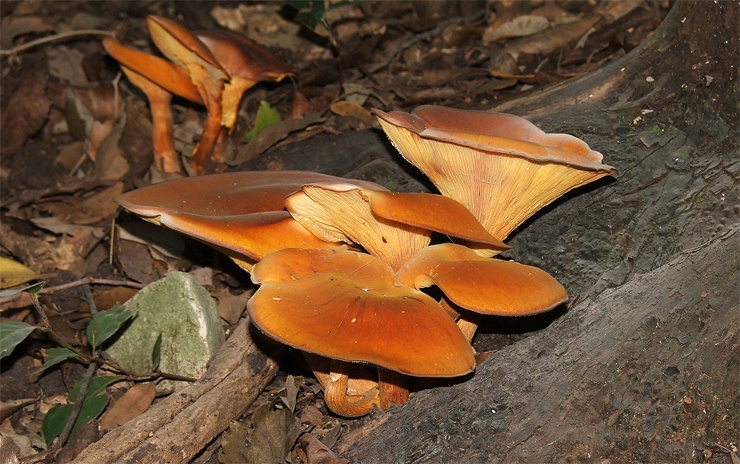
Olive omphalot is a poisonous mushroom that grows in wooded areas on rotten stumps and rotten trunks of deciduous trees in Europe, mainly in the Crimea. Notable for its bioluminescent properties. Appearance resembles a chanterelle, but unlike it, the olive omphalot has Not nice smell and contains the toxin illudin S, which, when ingested by the human body, leads to very severe pain, vomiting and diarrhea.
9. Russula pungent
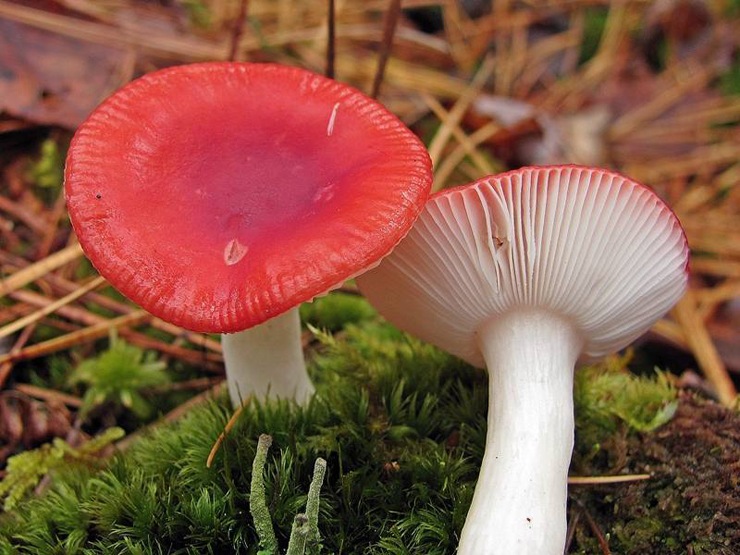
Russula stinging is widespread in the northern hemisphere in deciduous, coniferous and mixed forests. When properly processed, this mushroom is conditionally edible, but the taste is bitter, with a pronounced pungency. It is poisonous in its raw form and contains the poison muscarine. The use is not even large quantity raw mushroom leads to disruption of the gastrointestinal tract, abdominal pain, nausea and vomiting.
8. Panther fly agaric
![]()
The panther fly agaric grows in coniferous, deciduous and mixed forests in the temperate climate of the Northern Hemisphere. The mushroom is highly poisonous and contains poisons such as muscarine and mycoatropine that act on the central nervous system, as well as a number of toxic alkaloids that cause gastrointestinal disorders, hallucinations and can lead to death.
7. Foliotina rugosa
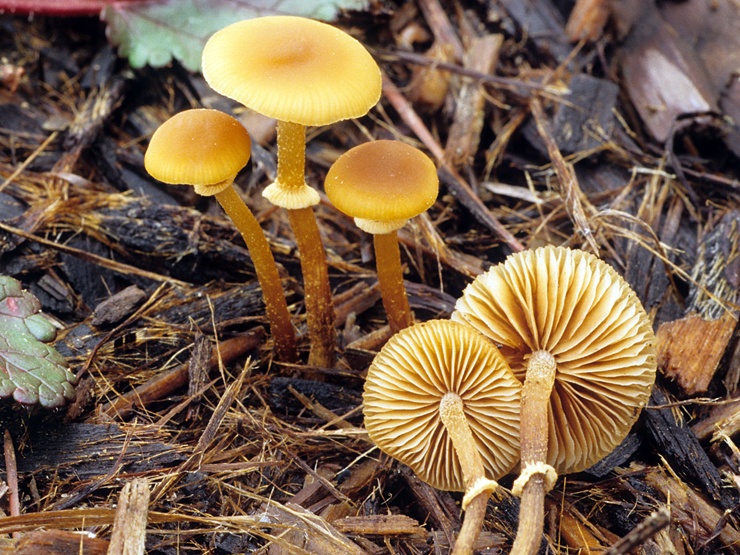
On the seventh line in the list of the most dangerous and poisonous mushrooms in the world is Foliotina rugosa - a poisonous mushroom that grows in Europe, Asia and North America. Contains a powerful poison called amatoxins, which is very toxic to the liver and is responsible for many deaths. Sometimes these mushrooms are confused with Psilocybe blue.
6. Greenfinch
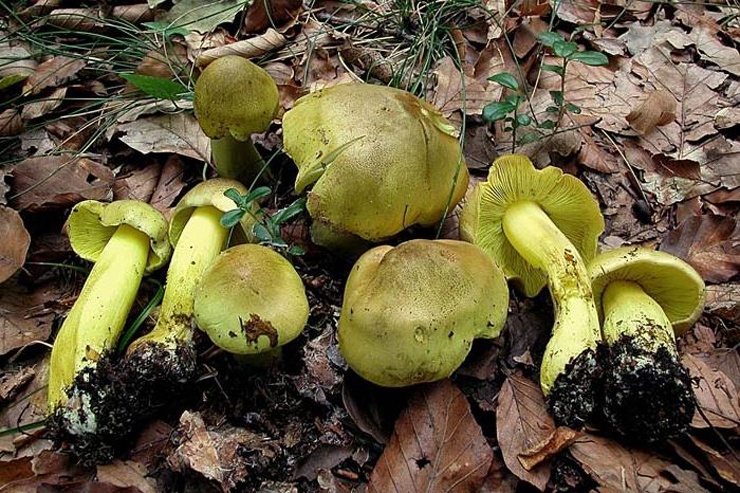
Greenfinch grows in small groups in dry coniferous forests on sandy soils in North America and Europe. Until recently it was considered good edible mushroom, but after the publication in 2001 of a report of poisoning due to the consumption of large quantities of greenfinches (12 cases, 3 of them fatal), it is suspected of being poisonous. Symptoms of poisoning include muscle weakness, pain, cramps, nausea and sweating.
5. Sulfur-yellow honey fungus

Sulphur-yellow false honey fungus is a very poisonous mushroom found on all continents except Africa and Antarctica. They grow on old stumps of deciduous and coniferous trees in August-November. When eaten, the mushroom causes severe, sometimes fatal poisoning. Symptoms appear within a few hours and are accompanied by abdominal pain, nausea, vomiting, sweating, diarrhea and bloating, sometimes blurred vision and even paralysis.
4. Thin pig

Svinushka thin - a poisonous mushroom, common in damp deciduous, coniferous and mixed forests, gardens, shelterbelts of the Northern Hemisphere in areas with a temperate climate. Mushroom for a long time was considered conditionally edible, but now its toxicity has been proven. Long-term consumption of thin pig as food leads to severe poisoning, especially in people with kidney disease. Potentially fatal complications include acute renal failure, shock, respiratory failure and disseminated intravascular coagulation.
3. Ergot purpurea
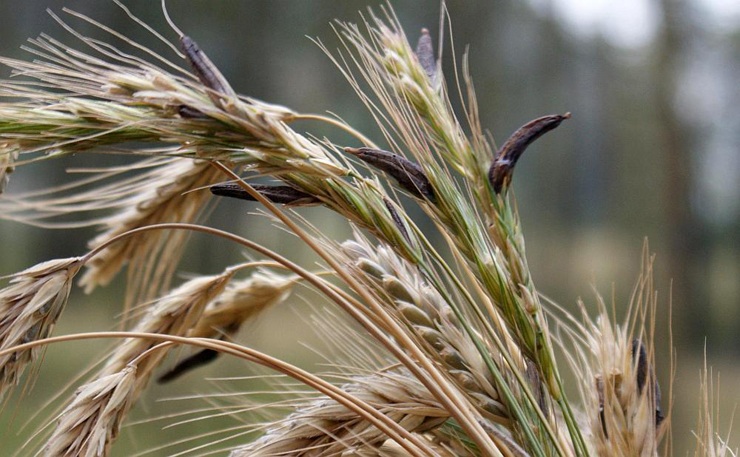

Amanita ocreata, also known as the "angel of death" is a deadly poisonous mushroom from the Amanita family. Distributed in mixed forests mainly in the northeastern part of North America from Washington to Baja California. Contains alpha-amanitin and other amatoxins, which cause the death of liver cells and other organs, as well as disruption of protein synthesis. Complications of poisoning include increased intracranial pressure, intracranial hemorrhage, sepsis, pancreatitis, acute renal failure and cardiac arrest. Death usually occurs 6-16 days after poisoning.
1. Pale grebe
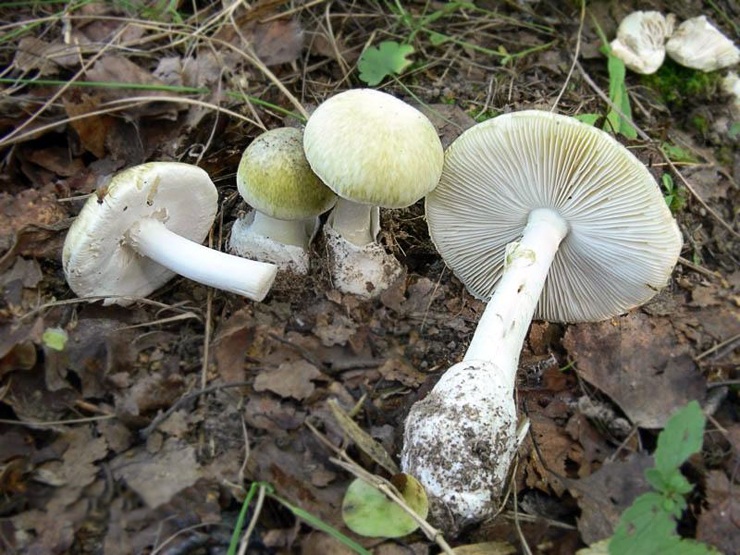
The toadstool is the most poisonous mushroom in the world. It is the cause of most fatal poisonings that occur after eating mushrooms. It grows in almost all types of forests in Europe, Asia, North America and North Africa. Loves dark, damp places. Contains two types of toxins, amanitin and phalloidin, which cause liver and kidney failure, and often the only way to avoid death is their transplantation. It is estimated that even half a toadstool contains enough toxin to kill an adult human. In addition, the toxicity of the mushroom is not reduced by cooking, freezing or drying it. Sometimes they are mistakenly collected instead of champignons and green russula.
Autumn has arrived and the mushroom picking season has begun. Any mushroom picker should have a good understanding of their types, be able to recognize poisonous varieties and quickly provide first aid in case of poisoning. Let's figure out together what the most poisonous mushrooms in Russia look like and why they are dangerous to humans.
List of life-threatening mushrooms
More than three dozen highly toxic mushrooms grow in our forests, often masquerading as their edible counterparts. The risk of poisoning from them is extremely high, and novice mushroom pickers need to take this into account. Next in order are the deadly poisonous mushrooms of Russia:
Toadstool pale. This mushroom is considered the most poisonous among all the gifts of the forest and is dangerous because in appearance it is very similar to edible species. It can often be confused with common russula or forest champignon. It grows from August to September mainly in deciduous and mixed forests. The pallid grebe can be recognized by its smooth gray, white or beige colour and a narrow stalk, thickened near the base. Even a small dose of toadstool is very toxic, and about 100 g of mushroom is enough for intoxication. The poison of the toadstool cannot be removed either heat treatment, nor drying. Signs of poisoning appear within two days from the moment of consumption. It provokes severe vomiting, stomach cramps, diarrhea and headache, a sharp decrease in blood pressure, often the victim’s body cannot cope with the effects of toxins. Subsequent therapy does not give the desired effect, which often leads to death.
Amanita stinking. The poisonous representative of the mushroom kingdom belongs to the fly agaric family, and was named so because disgusting smell rotten. Found in mixed and coniferous forests from early July to late November, it grows preferably in moist soil. Its conical cap is snow-white in color, abundantly covered with mucus and shiny, the leg is long but thin, with a growth in the middle. The minimum amount of mushroom is enough to cause severe poisoning. Once ingested, it causes convulsions, intestinal pain and increased salivation. Symptoms of intoxication, as in the case of the pale grebe, appear only after a few hours, and by the time therapy begins, its poison has already managed to infect internal organs. Because of the fetid odor, mushroom pickers often avoid it, so according to statistics, the mortality rate from it is low, but still this variety of fly agaric belongs to the extremely poisonous mushrooms.
Panther fly agaric. This is another representative of the fly agaric genus, which is extremely dangerous for humans. Panther fly agaric is difficult to identify correctly; the mushroom is often mistaken for edible varieties. It differs from its cousin the red fly agaric, which is known for its bright colors. Grows from late July to October in broad-leaved and coniferous forests. Usually lives in the vicinity of species suitable for consumption. You can distinguish it by its dense cap, most often it is brown in color, but occasionally it is brown or gray. Its surface is dotted with many whitish flakes, which are easily separated from the skin. The leg is thin, thickened at the base. It is highly toxic; after using it as food, the victim’s chances of survival are not very high. The first symptoms of poisoning appear after two hours. A severe attack of suffocation occurs due to spasms in the bronchi and lungs, the patient begins to have severe convulsions and loses consciousness.
The talker is whitish. Another type of poisonous mushroom that is definitely worth mentioning if we talk about the most poisonous mushrooms in Russia is the whitish talker. Grows in meadows and fields, can be found nearby forest edges and pastures, sometimes in squares and parks. It grows in colonies that form peculiar rings or “witch circles” from the end of July to the end of October. Her white hat convex in shape, a gray coating is clearly visible on it, the edges are turned inward, at the last stage of development they acquire the outline of a funnel. The leg is short, soft, cylindrical, covered in spots, and becomes very dark when pressed. in its tissues, muscarine toxin causes severe intoxication. Symptoms appear quickly; within 20 minutes the victim’s blood pressure drops, the pulse drops, the eyes become very watery, and he sweats profusely. If gastric lavage and antidote are not given in time, the patient may die.
Before you get ready to collect the gifts of the forest, you should once again remind yourself how to distinguish poisonous types of mushrooms from those that are suitable for food and do not forget the most important rule: if you have doubts about whether a mushroom found is edible, it is better not to risk it and leave it continue to grow in the forest.
Mushrooms, in addition nutrients, may also contain toxins. If their concentration is high, then such a product becomes dangerous to human health or even life. Deadly poisonous mushrooms in Russia can be found in any region. Therefore, lovers of quiet hunting need to remember distinctive features and favorite places for such specimens to grow.
Types of mushrooms
All mushrooms can be divided into four large groups: 
- Edible. They can be eaten without fear. They do not contain any toxic substances. Non-poisonous mushrooms can only pose a danger to those who suffer from allergies.
- Inedible. They do not contain toxic substances, but they cannot be eaten as they have an unpleasant taste or smell.
- Conditionally edible. In their raw form they are dangerous to humans. Their consumption can lead to serious poisoning. If they are subjected to proper processing, including heat, then they can be eaten.
- Poisonous. These are mushrooms with high content toxic substances. Even after processing they do not lose their toxic properties.. And for severe poisoning Sometimes it is enough to eat a small piece of such a product.
It is the poisonous specimens that pose the greatest danger to humans. The features of the most dangerous of them must be thoroughly studied.
Mushrooms high in phallotoxins and amatoxins
The most poisonous mushrooms in Russia contain phallotoxin or amatoxin. The danger of these substances is that symptoms appear after the poison has had its effect. A few hours later, severe diarrhea, cramps, and irresistible thirst begin. After three days the person feels noticeably better. But after another day the liver fails and the person dies. Phallotoxins and amatoxins are found in the following mushrooms: 
- The toadstool is the most poisonous mushroom in the world. Inexperienced mushroom pickers may confuse them with russula or row mushrooms. The pale grebe hides in coniferous forests, birch forests and oak groves. The diameter of the cap does not exceed 10 cm. In a young specimen it has a bell-shaped shape. With age it becomes flat. Color can vary from white to yellowish-olive. Frequent records have White color. The maximum length of the leg is 12 cm. It is hollow inside. May be white or have a slight yellowish tint. A large concentration of toxins is found in all parts of the mushroom, including the mycelium and spores. This is the most dangerous mushroom on earth, so information about it should be known to all mushroom pickers without exception.
- Red fly agaric. This bright, attractive mushroom is difficult to confuse with others. It is distinguished by a convex cap, colored bright red with white or yellowish flakes. Young specimens may not have such flakes. The plates are white. The length of the leg can reach 20 cm. It is also painted white and has a yellowish ring. The fly agaric loves coniferous, mixed and deciduous forests. He feels most comfortable in a birch forest.
- Galerina bordered. It is often confused with summer honey mushrooms. The diameter of the cap does not exceed 5 cm. Its shape is initially bell-shaped, and as it grows it turns into a flat one. Painted brownish-yellow. After rain, the color may change. The leg is thin, no more than 0.5 cm in diameter. Length up to 5 cm. Has a yellowish ring covered with a powdery coating. Most often, galerina can be found on rotting coniferous wood.
Correctly recognizing edible and poisonous mushrooms can save lives. Even small piece this product can be fatal.
If you doubt that a mushroom you find in the forest is edible, do not pick it. It's better to return home with an empty basket than to risk your life.
Mushrooms containing muscarine
Muscarine belongs to the group of neurotoxins. First of all, it affects the human nervous system. All poisonous mushrooms containing this substance can lead to hallucinations. Consumption of large quantities of this product and untimely provision of assistance can lead to death. The first signs of poisoning appear half an hour after consumption. Initially, the complexion changes, salivation increases, shortness of breath appears, the victim falls into a feverish state, and the heartbeat quickens.
Poisonous Forest mushrooms containing muscarine: 
- Panther fly agaric. Prefers coniferous and deciduous forests. Its cap can reach 10 cm in diameter. Painted red-yellow or brown. Small white flakes are scattered over the entire surface. White leg has a thickening at the bottom. In its upper part there is a wide ring. Has white thin plates.
- The fiber is sharp. A small mushroom, the diameter of the cap does not exceed 4 cm. Young specimens have a bell-shaped cap. As it develops, it becomes flat-convex with a small tubercle in the center. The cap of old fibers cracks. The pulp oxidizes in air and changes color. The length of the leg does not exceed 4 cm. It has a cylindrical shape, slightly thickening at the bottom. On its upper part you can notice a light powdery coating. Fiberwort can be found in coniferous forests and near swamps. The shape of the cap of these mushrooms is similar to honey mushrooms, which makes them dangerous for inexperienced mushroom pickers.
- The talker is whitish. The edges of the cap are slightly wavy and slightly curved at the bottom. Its diameter does not exceed 6 cm. It is painted white or light gray. A powdery coating is noticeable on the surface of the cap, which is easy to remove. In damp weather the mushroom becomes slimy. The diameter of the leg does not exceed 0.5 cm. Its length is no more than 4 cm. There are small nut-colored spots on the surface of the leg. These poisonous mushrooms grow on forest edges, clearings and small clearings. Sometimes you can even see them in a city park.
- Earthen fibre. The small cap has a conical shape. As the fungus develops, it straightens out. You can see a small bump in the center. The color of the cap can be different: white, cream, purple or light pink. Small cracks are visible on the edges. The pulp has an unpleasant odor. The leg is thin, no more than 6 cm long. It can be straight or slightly curved.
The toxic poison contained in such mushrooms can cause irreparable harm to your health. Therefore, before going into the forest, carefully study the characteristics of poisonous specimens.
If you notice the first symptoms of mushroom poisoning, call immediately ambulance. Self-medication in this case can cost you your life.
Mushrooms containing intestinal toxins
Poisonous mushrooms also include those that contain intestinal toxins. The use of such a product leads to serious gastric and intestinal disorders. The first symptoms appear after a couple of hours. A person suffers from attacks of nausea, severe headaches, vomiting and diarrhea. Such poisonings rarely lead to death, but have a negative impact on human health. These mushrooms include: 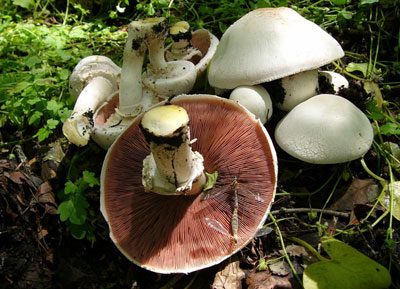
- Entoloma is poisonous. Most often found on the edges or near bushes in the young part of the forest. The entoloma cap is quite large, its diameter can reach 17 cm. It has a white or flesh color. The length of the leg is up to 10 cm. It has a regular cylindrical shape and a velvety surface that is pleasant to the touch. After breaking the entoloma, you will feel the light aroma of fresh flour.
- Yellow-skinned champignon. It can be identified by its large cap covered with yellowish skin. In the center you can see a small brown spot. If you press on the cap, its color changes slightly and becomes more yellow. The cap of young specimens has a rounded shape. As it matures, it becomes bell-shaped. The height can reach 15 cm. At the same time, the leg is quite thin, no more than 2 cm. It is hollow inside. If yellow-skinned champignon is cooked, a pungent phenolic odor will be felt. This mushroom actively begins to grow after summer and autumn rains. You can find it in mixed forests.
- False honey fungus is sulfur-yellow. It is widely distributed in forests of various types. It can be seen on stumps or at the bottom of tree trunks. The cap is bell-shaped and does not exceed 5 cm in diameter. As the mushroom develops, it becomes flat. There is a small tubercle in the middle. The hollow leg can be either straight or with a slight bend. Its length does not exceed 10 cm, and its diameter is 6 cm. The pulp has a bitter taste and a specific aroma.
It is better to study which mushrooms are poisonous before going into the forest. This way you will protect yourself and your loved ones from poisoning and, as a result, serious health problems.
Mushrooms containing hemolytic poisons
 Exposure to hemolytic poisons leads to hemolysis. This is the process of damage to red blood cells, after which the blood becomes homogeneous and turns bright red. Against the background of this problem, anemia, leukemia and other blood diseases can develop. Signs of poisoning by mushrooms containing hemolytic poisons appear after 12 hours. In case of severe intoxication, this time can be reduced to two hours. The first symptoms are severe fatigue, dizziness, headache, colic in the stomach, attacks of vomiting.
Exposure to hemolytic poisons leads to hemolysis. This is the process of damage to red blood cells, after which the blood becomes homogeneous and turns bright red. Against the background of this problem, anemia, leukemia and other blood diseases can develop. Signs of poisoning by mushrooms containing hemolytic poisons appear after 12 hours. In case of severe intoxication, this time can be reduced to two hours. The first symptoms are severe fatigue, dizziness, headache, colic in the stomach, attacks of vomiting.
Such mushrooms include the common string. It can be found on sandy soil. He likes to settle on forest edges, roadsides, and clearings. Features an unusual hat. It looks like a human brain. Has folds and grooves. Colored grey, reddish or brown.
Recent research by scientists has proven that the line, in addition to hemolytic poisons, contains gyromitrin. This is a deadly substance for humans, which does not collapse even after prolonged boiling. IN Russian mushrooms the concentration of gyromitrin is not high, so the lines can be eaten under the condition correct processing. But for the safety of yourself and your loved ones, it is better to refuse to use such a product.
Mushrooms containing orellanine
Orellanine has a damaging effect on the kidneys, respiratory system and musculoskeletal system. Poisoning can manifest itself only two weeks after intoxication. There is a significant increase in the volume of urine excreted, pain in the stomach, attacks of vomiting, and a feeling of dry mouth. Failure to provide medical care in a timely manner leads to kidney failure and, as a consequence, death. This substance is found in the following mushrooms: 
- Plush web spider. The cap does not exceed 8.5 cm in diameter. It looks matte, covered with small scales. In young specimens it has a spherical shape. As it gets older it becomes flat. It has a brown-red or orange color. The plush webweed can be found rarely. It prefers proximity to oaks or birches, and occasionally conifers.
- The cobweb is the most beautiful. The diameter of its cap can vary from 3 to 8 cm. As it grows, it changes shape from bell-shaped to flat-convex. There is a small tubercle in its center. The cap has an attractive velvety surface, sometimes with scales on it. It is colored brownish-red or brownish-red. The plates grow to the stem. The cylindrical leg has a length of no more than 12 cm. Most often, the most beautiful spider web is found in the central part of Russia and Siberia. It prefers coniferous and mixed forests.
The enchanting mushroom aroma annually attracts a large number of lovers of quiet hunting. But before you go into the forest, study carefully dangerous mushrooms and learn to distinguish them from edible ones.
When going on a “mushroom hunt,” many people think about the dangers of poisonous mushrooms. And no wonder, because the same type of forest fruit can be a deadly mushroom, and at the same time contain useful material, used in pharmacology.
This article offers a description of poisonous mushrooms, first aid recommendations for poisoning with poisonous mushrooms, as well as others useful tips regarding such tasty, but sometimes extremely dangerous gifts of the forest.
Residents different countries or even regions of the same state may treat mushroom species completely differently. For example, some mushroom pickers consider champignons toadstools and even mark their growing areas with signs “Caution! Poisonous mushrooms." Although everyone knows that this is a magnificent edible delicacy, consumed in many world cuisines. Apparently the reason is that the most poisonous mushroom is pale grebe- it is very easy to confuse it with edible champignon, and this is fraught with severe poisoning.
The most poisonous mushroom: toadstool


The leader among poisonous and even deadly mushrooms. In this case, poisoning makes itself felt only 8-12 hours after the poison enters the body.
If a person eats a poisonous mushroom, a series of attacks occurs, which are accompanied by severe abdominal pain, vomiting, diarrhea and cold sweat. The limbs begin to get cold, the pulse slows down, but the victim still remains conscious. Without immediate medical attention, death occurs after approximately two weeks.
Poison in fly agaric mushrooms
Fly agaric poisoning is not so strong and appears after a couple of hours. This is explained by the fact that the poison content in these mushrooms is not as high as in pale toadstools.
The victim begins to hallucinate, vomiting, convulsions, and diarrhea. Such poisonings rarely end in death, although fly agaric mushrooms contain galvelic acid, one of the most dangerous. It’s good that this poisonous type of mushroom is easy to identify: the rings on the leg of the fly agaric are clearly visible, and it itself bright color and has club-shaped thickenings with a sheath.
Deadly mushrooms: poisons and toxins in mushrooms
Deadly mushrooms contain toxic substances, but despite this, they are called. For example, the toxin gyrotomine from the common string is completely removed with careful heat treatment. If the mushrooms are not boiled in boiling water with several changes of water, then this toxin will disrupt the natural metabolism of amino acids and block the action of vitamin B6, which is vital for humans.
Neurotoxins are a class of mushroom poisons that, as a rule, do not kill, but cause a lot of harm. When they enter the human body, they disrupt the transmission of any nerve impulses. Poisoning is accompanied by vomiting, nausea, fever, excessive salivation, headache and weakness. In some cases, visual hallucinations and unpleasant tinnitus may occur. Often, even after the end of treatment, there may be consequences of poisoning that are difficult to cope with.


Amanita and Patuillara contain such a dangerous toxin as muscarine, which causes the development of mycoatropine syndrome. But if everyone knows the fly agaric, then Patouillard fiber is easily confused with russula. Its main difference is the protruding hump in the center of the cap. Fiber poisoning begins with slight disturbances in visual abilities and increased salivation, then diarrhea and vomiting are added, and blood pressure increases. Many mushrooms contain enzymes that can be digested by a healthy body. However, if a person has any problems with the intestines or pancreas, then it is not worth taking risks and trying these types of mushrooms (for example, pig mushrooms).
Help for poisoning: what to do if you eat a poisonous mushroom
Knowing what to do if you eat a poisonous mushroom can save your life and the life of the poisoned person. It is extremely important to know what to do if you are poisoned by poisonous mushrooms, especially when the first symptoms appear.
The danger is that in most cases, symptoms do not appear immediately, so it is important to take prompt measures. First aid for poisoning with poisonous mushrooms is Activated carbon and drinking plenty of water. Laxatives or emetics will also help clear the stomach and intestines of toxic substances. Under no circumstances should you drink alcohol: it will only speed up the absorption of the poison into the blood. If you feel unwell after eating mushrooms, you should immediately seek medical help. And most importantly, do not take mushrooms unless you know exactly what class they belong to. It is better to bring home a very small harvest, but remain healthy and protect loved ones from the serious consequences of poisoning. If you consider yourself new to the so-called quiet hunt, before going into the forest, carefully study the guide to the types of mushrooms; it is advisable that it contains photographs. Take it with you and use it to check whether a mushroom belongs to a particular group. The most important thing in this matter is awareness and caution.




